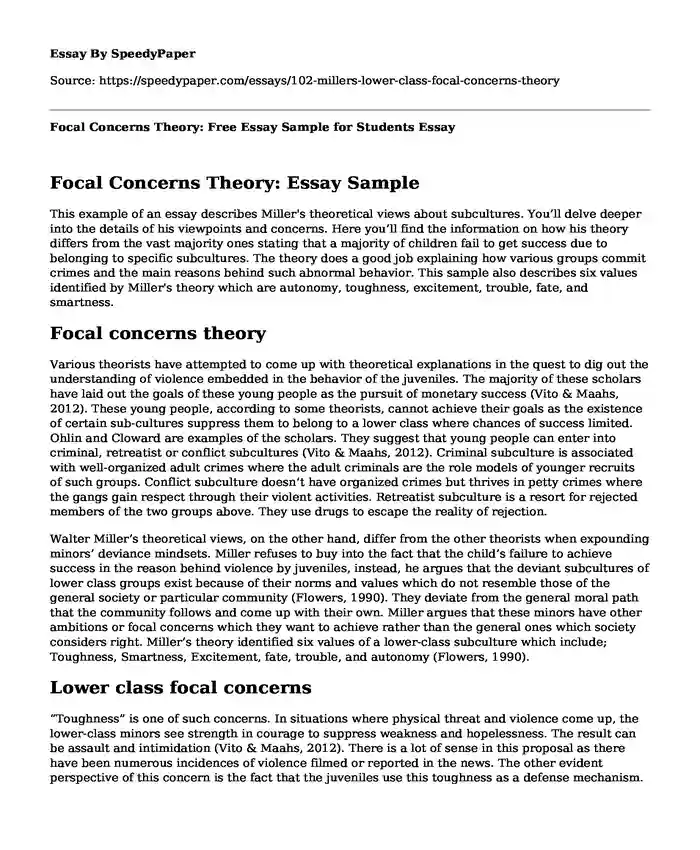Focal Concerns Theory: Essay Sample
This example of an essay describes Miller's theoretical views about subcultures. You’ll delve deeper into the details of his viewpoints and concerns. Here you’ll find the information on how his theory differs from the vast majority ones stating that a majority of children fail to get success due to belonging to specific subcultures. The theory does a good job explaining how various groups commit crimes and the main reasons behind such abnormal behavior. This sample also describes six values identified by Miller's theory which are autonomy, toughness, excitement, trouble, fate, and smartness.
Focal concerns theory
Various theorists have attempted to come up with theoretical explanations in the quest to dig out the understanding of violence embedded in the behavior of the juveniles. The majority of these scholars have laid out the goals of these young people as the pursuit of monetary success (Vito & Maahs, 2012). These young people, according to some theorists, cannot achieve their goals as the existence of certain sub-cultures suppress them to belong to a lower class where chances of success limited. Ohlin and Cloward are examples of the scholars. They suggest that young people can enter into criminal, retreatist or conflict subcultures (Vito & Maahs, 2012). Criminal subculture is associated with well-organized adult crimes where the adult criminals are the role models of younger recruits of such groups. Conflict subculture doesn’t have organized crimes but thrives in petty crimes where the gangs gain respect through their violent activities. Retreatist subculture is a resort for rejected members of the two groups above. They use drugs to escape the reality of rejection.
Walter Miller’s theoretical views, on the other hand, differ from the other theorists when expounding minors’ deviance mindsets. Miller refuses to buy into the fact that the child’s failure to achieve success in the reason behind violence by juveniles, instead, he argues that the deviant subcultures of lower class groups exist because of their norms and values which do not resemble those of the general society or particular community (Flowers, 1990). They deviate from the general moral path that the community follows and come up with their own. Miller argues that these minors have other ambitions or focal concerns which they want to achieve rather than the general ones which society considers right. Miller’s theory identified six values of a lower-class subculture which include; Toughness, Smartness, Excitement, fate, trouble, and autonomy (Flowers, 1990).
Lower class focal concerns
“Toughness” is one of such concerns. In situations where physical threat and violence come up, the lower-class minors see strength in courage to suppress weakness and hopelessness. The result can be assault and intimidation (Vito & Maahs, 2012). There is a lot of sense in this proposal as there have been numerous incidences of violence filmed or reported in the news. The other evident perspective of this concern is the fact that the juveniles use this toughness as a defense mechanism.
Miller proposes “Smartness” is another focal interest whereby the members of a group tend to outwit, outsmart or dupe other people. This attribute has resulted in conning of individuals, pick-pocketing in incidences of mild confusions, and the results have always been massive (Vito & Maahs, 2012). As a critique of Miller’s view, this trait can also be used by any other groups and not only this group, especially gangs with various characters. “Excitement” is another focal point which seeks thrills from dangerous criminal adventures. Member of this status finds thrills from drugs, sexual adventures, and gambling (Flowers, 1990). This trait is also witnessed in criminal subcultures. The people also believe in “fate,” that the way their lives is structured was how it was meant to be and that there is little to nothing anyone can do about it.
Members of lower-class cultures also have a trait of “trouble” that their life is centered on creating upheavals and violence and they cannot escape in case of anything. They face the fight and don’t care whether they die or not (Flowers, 1990). Miller also cites “autonomy” as a delinquent circumstance of the typical working class youth. They believe in self-direction as the immunity from arbitrary exercise of authority. They are always rebellious of external authority as well as having their forms of rules of operation.
In conclusion, Walter Miller sees delinquency as a contribution to aggressive cultural values rather that inability to achieve success. A combination toughness, smartness, excitement, fate, trouble, and autonomy creates crime loving way of life and different from the general community.
References
Flowers, R. B. (1990). The Adolescent criminal: An examination of today's juvenile offender. Jefferson, N.C: McFarland.
Vito, G. F., & Maahs, J. R. (2012). Criminology: Theory, research, and policy. Sudbury, Mass: Jones & Bartlett Learning.
Cite this page
Focal Concerns Theory: Free Essay Sample for Students. (2018, Feb 16). Retrieved from https://speedypaper.com/essays/102-millers-lower-class-focal-concerns-theory
Request Removal
If you are the original author of this essay and no longer wish to have it published on the SpeedyPaper website, please click below to request its removal:
- Free Essay Sample on Spiritual Wellness
- Free Essay: Electronic Health Record Systems in Medicine and Healthcare
- Personality Theories, Free Essay with a Case Study
- Those Winter Sundays: Gender and Sexuality, Free Essay on the Poem
- Literary Essay Example: Disfigured Heritage in Kindred
- Lookism - Free Essay Examplefrom Our Database
- Paper Example. Latest Progress in Cancer Immune Escape
Popular categories





